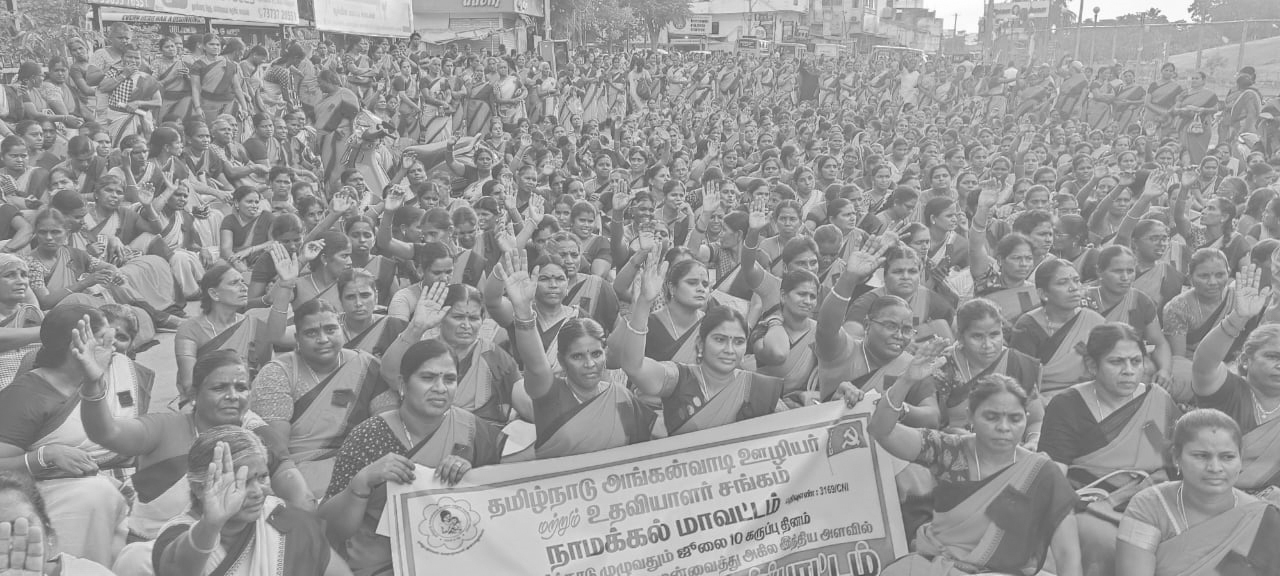
AR Sindhu
NEARLY two lakh anganwadi workers and helpers across 28 states participated in demonstrations on July 10, observing Demands Day at the call of the All India Federation of Anganwadi Workers and Helpers (AIFAWH). Every year, AIFAWH marks July 10 as All India Demands Day. This year, the Centre of Indian Trade Unions (CITU) called for demonstrations at various levels on the same day to highlight the basic and immediate demands of the working class, including scheme workers.
In many locations, anganwadi unions synchronised their demonstrations with the CITU programme. Despite torrential rains in several states, workers turned out in large numbers within one month of the new government's tenure. Demonstrations were primarily held at district levels, with memoranda addressed to the finance minister and the women and child development (WCD) minister submitted through sub-divisional magistrates (SDMs) and district programme officers (DPOs).
In Andhra Pradesh and Tamil Nadu, around 30,000 anganwadi workers and helpers participated. There was massive participation in Kerala, West Bengal, Gujarat, Punjab, Madhya Pradesh, and Assam. Demonstrations were also held in the Andaman and Nicobar Islands and Pondicherry.
The demonstrations addressed issues such as regularisation, minimum wages, pensions, and the implementation of the Supreme Court order on gratuity. AIFAWH also raised concerns about the quality of services and infrastructure in anganwadi centers. According to NFHS-6 data, over one-third of children under five are stunted, wasted, and underweight. Anemia levels are alarmingly high, affecting 57.0 per cent of women, 59.1 per cent of adolescent girls, 52.2 per cent of pregnant women, and 67.1 per cent of children under six. On average, nearly 9 lakh children under six die every year in India.
The demonstrations highlighted that the NDA-1 and NDA-2 governments have been continuously cutting budget allocations for the Integrated Child Development Services (ICDS) Scheme while declaring many new features. Even necessary requirements for increased food supply allocations were not met, severely affecting basic services of anganwadis. In many states, the central share of remuneration has not been paid for months. The National Education Policy (NEP) 2020 has also forced pre-school education to shift to schools, leading to the closure of anganwadis.
The main demand was to increase budget allocations for ICDS in the upcoming central budget. The detailed demands are as follows:
Increase the budget allocation for ICDS in the ensuing budget.
Strengthen ICDS with full infrastructure and good quality food. Develop anganwadi centers as full-time anganwadi cum crèche with adequate resources.
Strengthen the Early Childhood Care and Education (ECCE)/pre-school education component in anganwadis. ECCE/pre-school should not be part of the formal education system. Enact the Right to ECCE with anganwadi centers as nodal agencies.
Regularise anganwadi workers and helpers as Grade III and Grade IV government employees. Pending regularisation, implement the 45th ILC recommendation – minimum wages of Rs 26,000 per month, Pension of Rs 10,000 per month, PF, ESI, etc. Uniform service conditions for anganwadi workers and helpers throughout the country. Constitute a Pay Commission for scheme workers immediately.
Immediately implement the Supreme Court order on gratuity to anganwadi workers and helpers.
Recognise the democratic and trade union rights of anganwadi workers and helpers; Develop bipartite mechanisms at all levels.
No privatisation of ICDS in any form. No privatisation of public sector enterprises and services.
Scrap labour codes.


